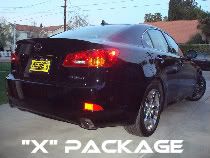
Found some FAQ literature on Coolant. Hopefully this will clarify some questions some may ask. Very interresting stuff.
 http://www.penray.com/bulletins/water.htm
http://www.penray.com/bulletins/water.htm
Category: Coolants
Bulletin No. 99.023
Date: 9/20/99
Introduction:
Penray frequently is asked to recommend practices relative to water selection for the blending of engine coolant. ASTM publishes the following recommendation, and a discussion follows.
ASTM Water Quality Recommendation (from D-4985):
Discussion:
Engine coolant is a mixture of antifreeze and water, usually 50% each. ASTM specs require the antifreeze be formulated so that when it is mixed with water at 50%, the freeze point is no higher than -34°F (-37°C). A great deal of work and expense goes into the formulation of quality antifreeze. Reputable companies use high quality ethylene glycol, and purchase deionized water and chemicals that are certified to be low in contaminants, such as chloride, to blend the anti corrosion properties into the finished product. Frequently, the effort seems somewhat wasted when the end user indiscriminately uses water unsuitable for engine coolant to blend with the antifreeze.
Probably the poorest choice of blending water is well water. The minerals, when introduced into engine coolant are the source of several concerns.
Calcium: combines in engine coolant to form scale on hot heat exchange surfaces. Scale is an efficient insulator, and the result is localized engine overheating that can cause component failure.
Magnesium: Magnesium also can form scale, creating localized overheating and warped engine heads. It is the second of the two components (with calcium) measured to determine the degree of "water hardness". Water that contains calcium and magnesium is defined as "hard"; the concentration of the two chemicals combined determines the level of hardness.
Silicate: In water, silicate would be detected as the result of sand, not sodium silicate inhibitor. Sand is frequently found in cooling systems, and is associated with premature wear due to abrasion in various areas of the cooling system.
Chloride: Municipal drinking water most often is, in fact, acceptable for engine coolant. A water test can determine the quality of municipal water. Nevertheless, most municipal waters contain chlorine, resulting in the formation of chlorides in the coolant. Chlorides are aggressive to aluminum.
Oxygen: Anyone who has tried deionized water knows it tastes nasty. This is due to its lack of oxygen. Oxygen contributes tremendously to metal corrosion and depletion of inhibitors. City water is full of oxygen making it suitable for drinking and keeping pet fish. Water with low oxygen levels is preferable for coolant.
Therefore, the argument for distilled or deionized water is made on the basis that such water contains fewer reactive chemicals, resulting in optimum coolant life and performance. It is also true that Penray antifreeze chemistry is formulated with certain safeguard additives chosen to address typical city water. This is another "good - better - best" choice; relating city water, shop blending DI water, and prediluted coolant from a blending plant representing the three quality choices. No one recommends using well water for engine coolant.
http://www.penray.com/coolantguide/Why Maintain Your Coolant?
Using and maintaining a properly formulated coolant is one of the most important aspects of engine maintenance. 40% of engine breakdowns are a direct result of improper coolant maintenance. Don't believe it? Check out this graphic representation and see if you have any of these problems.
The intent of this Coolant Maintenance Guide is to provide the information required to help diesel engine operators avoid cooling system problems. Coolant is used to meet the following basic requirements:
-Provide an adequate heat transfer medium.
-Protect against cavitation damage.
-Provide a corrosion-resistant environment.
-Prevent formation of scale and deposits.
To achieve these requirements, coolants must be of good quality. Demineralized or deionized water mixed with fully formulated antifreeze is the best choice. Pencool 3000 may be used to provide corrosion protection in coolant, while Pencool 2000 recommended for water-only coolant.
Penray recommends fully formulated, phosphate-free extended service interval (ESI) coolants, like Fleet Charge. Use antifreeze or coolant that meets ASTM D-6210 or D-6211 "Type A" phosphate-free requirements. The maintenance procedures described below for "antifreeze" or "coolant" apply equally to PG and EG.
(Note: Coolant recycled by reverse osmosis or ion exchange, properly re-inhibited to meet RP-329 or 330 requirements has been demonstrated to provide service equivalent to virgin antifreeze. Recycled antifreeze or coolants of these types are preferred.)
For best overall performance, use a coolant consisting of 33% to 60% fully formulated antifreeze. Fully formulated antifreeze should be used without the addition of any additional coolant additive. If a pre-diluted fully formulated coolant is purchased, simply fill the clean cooling system. Always verify that the freeze point and nitrite concentrations are correct with a Penray test strip, to insure engine protection. Many antiquated antifreeze formulations available in the market may not contain all the required additives. Penray recommends against using these types of antifreezes.
After billions of miles, Penray knows what works in cooling systems. For more information about Penray cooling system products, or for technical data, check out our catalog and technical bulletins. In the meantime, go through the Coolant Maintenance Guide to check your coolant .
http://www.penray.com/bulletins/compatibility.htmIV. WARNING:
There are organic acid antifreeze/coolants on the market marketed as "extended life" coolants (i.e. DEXCOOL®, Texaco® Extended Life Antifreeze and Caterpillar® Extended Life Antifreeze. These products' performance may be compromised if mixed with conventional coolants. Do not mix the two. Organic acid antifreeze/coolant can be recognized by its distinctive orange or red-orange color.
http://www.penray.com/bulletins/dexcool.htmHow can a customer tell if he has DEXCOOL?
If the customer owns a GM car and has orange coolant, then its DEXCOOL! In GM trucks the coolant is "orange- red", indicating that it contains nitrite. Orange coolant in Daimler-Chrysler® vehicles is NOT Dexcool. (Daimler Chrysler owners with orange color factory coolant should consult their owners' handbooks).












